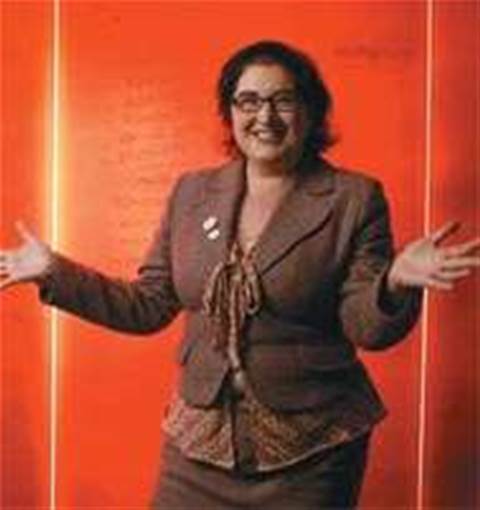But her training also included some computing knowledge so she chose a PC support role for her first job. “I worked for a management guru who used to ring me up and ask how to change a directory in DOS! So that was very interesting, but I didn’t last long in PC support because I was adopted by those people who would come and visit me and sell me all the stuff,” Arrigo says.
She applied for a job with HP reseller AMS in 1998, which later became Prion. That was run by the Brackin brothers, including Volante’s Allen Brackin.
Arrigo built up a dealer channel for them. Then she worked for a Toshiba wholesaler. “Once you’re in the market and know who all the resellers are, people want to keep employing you but it was getting very boring,” she says. “So I went back to uni and did a graduate diploma in marketing and ended up acquiring a job at another Compaq reseller.”
On the superhighway
In 1995, Arrigo told a cafe owner acquaintance about an ICQ conversation she had just had with her older brother, Frank Arrigo, who was in Seattle at the time. “My brother was saying: ‘They’ve got internet cafes here’. And he goes, ‘they’re really groovy’. And I was talking to this cafe owner and he goes: ‘Oh, my God, will you build me one?’,” she recalls.
The cafe owner later fronted up to her with $10,000 in cash in his pocket and ordered her to build him one. She installed the internet and did the hardware setup for the cafe -- soon renamed Netcafe -- in trendy Acland Street in St Kilda.
It was the first internet cafe in Melbourne, she says. Routing and ports were quite expensive then. "To do it without having six telephone lines from Telstra, you’d use a Linux server," Arrigo says. Netcafe soon attracted all kinds of attention, from the public, wannabe techo types and the news media. Channel Seven’s Healthy, Wealthy and Wise show came out to do a story on it.
Sadly, after an initial flurry of interest, Netcafe was closed down after about a year. It had cost $6 to surf the internet for half an hour. Meanwhile, more internet cafes opened, libraries started to supply internet access and companies like VicNet got established.
What did keep things going for a while, Arrigo says, was using the cafe to offer an internet training course, teaching what chat, URLs and bulletin boards were -- “things like that”. “It was actually not easy for the cafe owner,” she says. “And he probably didn’t make the million dollars he wanted to make, and ended up closing the shop. But it was very exciting times.” Arrigo says a whole movement began to give people access to computer-based information. Even government, particularly the states, started investing and supporting the promised internet boom.
There was a backlash. Some people feared whole generations would never leave their houses, having become “addicted” to the new technology. But Australia escaped much of that, according to Arrigo.
“We have this kind of environment where people always argue with new technology,” she says. “No-one would let their kids stay on the internet in their room in Australia, I don’t think.”
However, Arrigo discovered it was different in Singapore, where she went to work for NCS. “In Singapore, I noticed how tragic a lot of use was. Some people used the internet to the extent where they forgot about normal other parts of life,” she says.

Rita with WDG colleagues
Fighting techno-fear
Excessive use aside, Arrigo considers a major part of her role has always been fighting Luddism in the ranks. She realised she is galvanised by the chance to teach people about technology and its benefits. “I was more about people overcoming the fear of machines,” she says.
Arrigo says she was rattled by older people who didn’t like technology. “They would say, ‘What’s the benefit of that? How is it going to help me?’ There really was a feeling technology wasn’t that great. I think techno-fear is probably still a problem. Not in our industry, but in the community around us,” she says.
She likes to compare Australia’s facility with IT, though, with places like the US. “US had a terrible mobile network and they launched this poor little mobile thing that would only work in New York and were getting really excited about it,” Arrigo says. “People bag Telstra and Optus but we’re a lot luckier in our telco services than the US.” Arrigo’s experience is diverse.
Melbourne radio station 3RRR still has a show called Byte Into It, designed to demystify IT, that Arrigo started years ago. It earned her the nickname “Digital Diva” and helped inspire geekgirl.com.au to list her as one of their Women in IT Role Models.
She even met Bill Gates once, on a visit to her brother Frank in the US, who still works for Microsoft in a .NET role. “[Frank] invited me to an executive briefing and he was there,” she says. “I got to meet Bill. I thought he was great!” Gates, she says, struck her as something of a visionary. “But you don’t want to say that to too many people. They might canonise him!,” she laughs. “I still think he should give more of his money away.”




_(11).jpg&h=142&w=230&c=1&s=1)





.jpg&w=100&c=1&s=0)
_(8).jpg&w=100&c=1&s=0)







.jpg&q=95&h=298&w=480&c=1&s=1)





